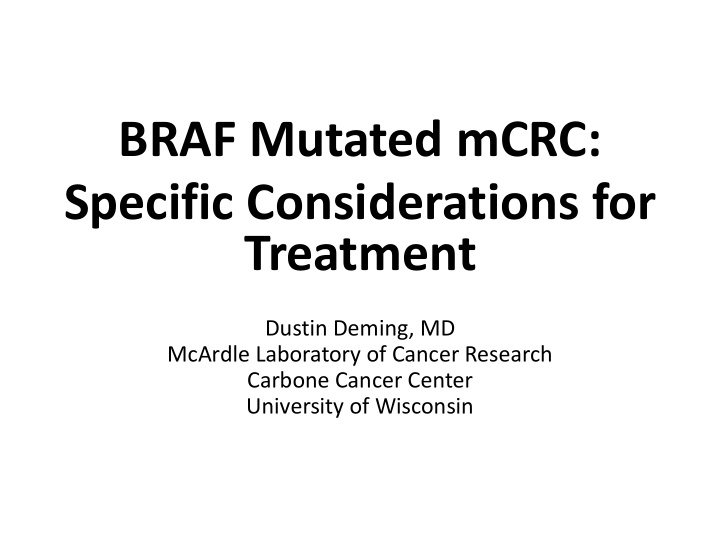



BRAF Mutated mCRC: Specific Considerations for Treatment Dustin Deming, MD McArdle Laboratory of Cancer Research Carbone Cancer Center University of Wisconsin
EGFR PI3K RAS AKT P BRAF P BRAF P MEK MAPK P N u Transcription factors c l e u s Survival Migration Cell Cell cycle growth progression
BRAF Mutations Occur in ~8-10% of colorectal cancers • 80% are BRAF V600E mutations Concomitant Alterations include: • APC • TP53 • PIK3CA • CTNNB1 • Hypermethylation resulting in loss of MLH1 • Less common missense mutations in MLH1 , MSH2 • Largely mutually exclusive with KRAS/NRAS mutations
Cl Clinical Ch Characteri ristics • More common in female and elderly • Right-sided predominance with larger primary tumors • Associated with: • MMR deficiency • High grade • Peritoneal disease • Metastatic lymph node involvement
BRAF BRAF V600E 600E – Prognostic c Implications (Cremolini, et al., Lancet, 2015)
No Not t Al All BRAF BRAF Mutati tions are e Cr Crea eated ed Equally y (Jones, JCO, 2017)
In Vitro Kinase Activity (Jones, JCO, 2017)
Fi First-lin line treatment for or BRAF V600E mCR mCRC • Only a third of patients go on to second-line therapy • FOLFOXIRI + Bevacizumab (TRIBE and CHARTA studies) • FOLFOX or FOLFIRI +/- Bevacizumab (Seligmann, Ann Oncol, 2017; Cremolini, Lancet, 2015; Schnoll, ASCO, 2017)
TRIBE Study TR N=32 FOLFOXIRI FOLFIRI + + Bev Bev OS 19 mos 10.7 mos PFS 7.5 mos 5.5 mos RR 56% 42% (Cremolini, et al., Lancet, 2015)
BRAF V6 V600E MMR deficient Secon Se ond-lin line e Trea eatm tmen ent ORR DCR Ref Nivolumab (n=12) 25% - Overman, JCO, 2018 Nivolumab and 55% 79% Overman, JCO, 2018 Ipilimumab (n=29)
BRAF Targeted Th Therapeutic Op Options 1. Single agent BRAF inhibition 2. Doublet therapy 3. Doublet therapy plus chemotherapy 4. Triplet therapy
Single A Si Agent BR BRAF T Targeted Therapy Th n RR PFS Ref Vemurafenib 21 5 2.1 Kopetz, JCO, 2015 Dabrafenib 9 11 - Falchook, Lancet, 2012 Encorafenib 18 16.7 4 Gomez Roca, ESMO, 2014
EG EGFR Feedback Signaling (Corcoran, et al., Cancer Discovery, 2018)
Doublet BRAF Targeted Th Therapy n RR PFS Ref BRAF/EGFR Inhibition Vemurafenib/Panitumumab 15 13 3.2 Yeager, CCR, 2015 Vemurafenib/Cetuximab 27 4 4.5 Hyman, NEJM, 2015 Dabrafenib/Panitumumab 20 10 3.5 Corcoran, Cancer Discov, 2018 Encorafenib/Cetuximab 26 19.2 3.7 van Geel, Cancer Discov, 2017 BRAF/MEK Inhibition Dabrafenib/Trametinib 43 12 3.5 Corcoran, JCO, 2015 MEK/EGFR Inhibition Trametinib/Panitumumab 31 0 2.6 Corcoran, Cancer Discov, 2018
Ve Vemurafenib, Cetuximab, Irinotecan
Ve Vemurafenib, Cetuximab, Irinotecan
Triplet BRAF Targeted Th Therapy n RR PFS Ref Dabrafenib, 91 21 4.1 Corcoran, Cancer trametinib, Discovery, 2018 panitumumab Encorafenib, 30 48 8 Van Cutsem, GI binimetinib, ASCO, 2018 cetuximab
Su Summa mmary • BRAF V600 mutant cancers are a distinct subtype of CRC with unique clinical characteristics and a poor prognosis • Current treatment strategies include chemotherapy and targeted therapies. • Anti-PD1 therapies should be used in the setting of mismatch repair deficiency.
Futur Future e Dir irec ectio tions ns • Awaiting results of the BEACON phase III study of encorafenib, binimetinib and cetuximab. • First-line use of immunotherapy or targeted therapies • Anticipate studies examining the combination of these approaches
Recommend
More recommend